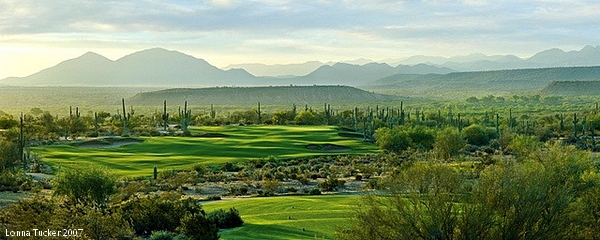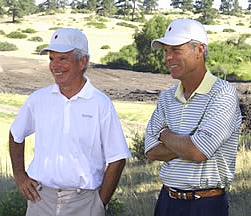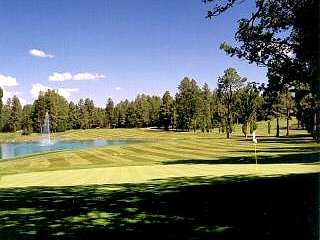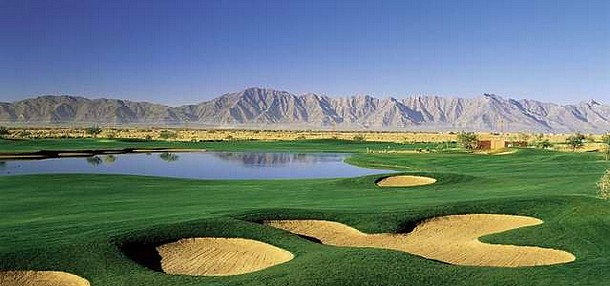We-Ko-Pa Saguaro Course – Arizona Golf Courses
If you were tasked with choosing the best piece of property in Arizona for a pair of golf courses, the site at We-Ko-Pa Golf Club would be one of your finalists. Both courses, Cholla and Saguaro, provide native-natural terrain and boast spectacular views.

The team of Bill Coore and Ben Crenshaw laid the Saguaro Course in place with their distinctively delicate hand about five years after the Cholla Course opened for play. It made WeKoPa Golf Club “the” place to play in Arizona and with the addition of Saguaro, it still is!
One of golf’s red-hot design teams of the past decade, Coore-Crenshaw did not disappoint with their stellar effort at We-Ko-Pa Saguaro, even if a few holes did turn out rather unique, like the super-short uphill par-3 ninth and super-challenging par-4 finish at the eighteenth.
Course conditioning and incredible desert-mountain views don’t get much better than here at We-Ko-Pa and the Saguaro Course offers up an entertaining mix of of short par 4s and long par 4s right in the middle of the surrounding natural splendor.
The golf course plays firm and fast throughout so don’t be frightened by the 469-yard par-4 first hole; your tee ball is going to run forever. Just remember that’s just as true at the 336-yard par-4 second or your tee-ball will run-out and find a fairway bunker you thought you were playing short of.
The signature 14th, a 538-yard uphill par 5, presents a different dilemma: a tempting split fairway and fantastic mountain views both vie for your attention. Here’s a tip: highly skilled players go right, the rest of us play to the left-side fairway – your choice.
The par-3 fifteenth is another favorite. The elevated tee tempers it’s 255-yard length, reducing your club selection by at least two clubs. The green complex below offers an open door for the baby-draw shot we all see ourselves playing from time to time. Go ahead and author one, the forgiving slope on the right-hand side of the green will collect those shots that stay straight.
One thing to definitely smile about is that We-Ko-Pa’s slightly shorter Saguaro Course (a little over 6,900 yards) allows walking and that’s a good thing. This is no level stroll through your local parkland muni though, you’ll be up and down through the natural arroyos that give this course it’s desert character.
 True to form, Messrs. Coore-Crenshaw left the fairway and green sites completely natural. Or as Crenshaw spun it:
True to form, Messrs. Coore-Crenshaw left the fairway and green sites completely natural. Or as Crenshaw spun it:
“We just kind of draped the grass over what was already there.’’
It’s the less is more, minimalist philosophy the dynamic-duo adheres to and it’s perfect for property this stunning. Another thing to like is the old-style bunkering, which undoubtedly is a Coore-Crenshaw strength. Not only are there several gaping pot bunkers on the Saguaro, there also are plenty of elongated fairway bunkers known as “furrowed brows’’ with a touch of wispy grass hanging over the edges strictly for effect.
Add it all up and Saguaro is pure, compelling golf in the desert. Also featured are a cool, rustic half-way house that looks like it was built in the days of yesteryear, and We-Ko-Pa’s striking clubhouse – it’s first-rate and ultra-chic in a new-age Native American way.
Arizona Golf Authority AZGA “Local Hang” for We-Ko-Pa Golf Club is the club’s panoramic patio, especially if you indulge in the magnificent mahi-mahi sliders with zesty Pico de Gallo and a draught of Drop Top amber ale. No wonder We-Ko-Pa markets the final moments of a day of golf as “good food with a view.’’
Click We-Ko-Pa Cholla Course to check out Saguaro’s sister course; these two pair for a world-class 36-hole day of Arizona golf.
Visit our Arizona Golf Course Reviews and read the AZGA Player’s review for every golf course in Arizona at http://www.arizonagolfauthority.com/coursedirectory/.
It’s “All Things Arizona Golf” from the Arizona Golf Authority.








